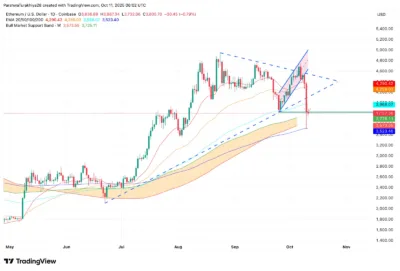- Ethereum trades near $3,805 as bulls defend key support levels.
- Breakdown below 100-day EMA signals short-term bearish pressure.
- Stablecoin inflows highlight resilience amid DeFi policy uncertainty.
Ethereum (ETH) is trading near $3,805, struggling to regain momentum after losing key support from its rising channel structure. The rejection near $4,800 triggered heavy selling, pushing the price below the 20-day and 50-day exponential moving averages (EMAs) and into the $3,700–$3,750 support zone.
This region now aligns with Ethereum’s bull market support band, making it the critical area buyers must defend. The current setup places Ethereum at a technical crossroads as traders weigh macro uncertainty against strong network fundamentals.
Also Read: Cardano (ADA) Price Prediction 2025–2030: Will ADA Break Past $0.90 Soon?
Ethereum Price Action and Technical Indicators
The daily chart shows Ethereum breaking out of its previous ascending channel and testing the lower boundary of a long-term symmetrical triangle. The breakdown has driven the price beneath the 100-day EMA ($3,968) and closer to the weekly bull support band ($3,573–$3,725).
The RSI has slipped below the neutral 50 level, reflecting weakening buying strength, while the MACD histogram remains deeply negative, confirming continued selling momentum. Unless Ethereum reclaims $4,000 soon, a deeper retracement toward $3,523—the 200-day EMA—cannot be ruled out.

Source: Ttradingview
If ETH manages to close above $3,968, traders anticipate a short-term recovery toward $4,259 and $4,600. Failure to hold the $3,573–$3,725 range, however, could expose ETH to further downside risk near $3,400, an area of historical demand.
DeFi Policy Threat Casts Shadow on Ethereum
The U.S. Senate’s new decentralized finance (DeFi) proposal has added regulatory pressure to Ethereum’s outlook. Although the bill does not directly name Ethereum, its broad definitions place the network at the heart of potential oversight.
Under the proposed framework, any entity providing front-end access to DeFi platforms must register as a broker with the SEC or CFTC. This requirement could encompass major Ethereum-based applications like Uniswap and Aave, potentially driving developers offshore and limiting U.S. user access.
Analysts warn that the policy could reduce network activity and liquidity in the short term. While Ethereum’s decentralized infrastructure remains robust, heightened regulatory uncertainty has slowed investor confidence and contributed to recent price weakness.
On-Chain Flows Show Persistent Outflows
Data from Coinglass highlights significant Ethereum outflows from exchanges. On October 10, ETH saw $677 million in net outflows, one of the largest single-day movements in recent months. Another $9 million left exchanges the following day, suggesting persistent caution among traders.
These consistent red outflow bars indicate that investors are moving assets into self-custody or sitting on the sidelines amid market uncertainty. Historically, heavy outflows often coincide with volatility spikes and short-term price weakness. For now, traders appear to be reducing exposure while awaiting clearer signals from both price action and regulation.
Stablecoin Inflows Offer Partial Cushion
Despite selling pressure, Ethereum continues to dominate as the primary settlement layer for stablecoins. Data shared by Coin Bureau shows that over $3 billion in stablecoins flowed into the Ethereum network over the last week—more than all other major blockchains combined.
This inflow underscores Ethereum’s enduring position at the center of DeFi and payments. Analysts note that such stablecoin growth often precedes renewed liquidity in decentralized exchanges and lending markets. While short-term sentiment remains cautious, the sustained capital inflows suggest that once policy clarity emerges, liquidity could quickly return to Ethereum-based markets.
Technical Setup Points to a Crucial Confluence Zone
Ethereum’s structure has now entered a critical confluence zone between $3,725 and $3,573, which serves as the last major buffer before the 200-day EMA at $3,523. This zone marks the intersection of long-term structural support and key psychological thresholds for traders.
A decisive close above $3,968 could trigger bullish momentum toward $4,420 and $4,600, while failure to defend $3,573 may open the door to a deeper correction near $3,400. At present, the momentum bias remains bearish below $4,000, reflecting Ethereum’s breakdown from its rising channel into its bull market support region.
Technical Outlook for Ethereum Price
Ethereum’s immediate resistance levels are set at $3,968, $4,259, and $4,600, while support levels lie at $3,725, $3,573, and $3,523. The 20-day EMA aligns near $4,290 and the 50-day EMA near $4,259, forming a dense resistance cluster.
For the broader trend to turn bullish, ETH must reclaim $4,000 and secure a close above this resistance band. Conversely, a decisive break below $3,573 could extend the correction to $3,400. Overall, Ethereum’s structure remains bearish in the short term but fundamentally sound, with strong on-chain liquidity providing a potential springboard for future recovery.
Price Prediction for 2025–2030
| Year | Minimum ($) | Average ($) | Maximum ($) |
| 2025 | 3,523 | 3,900 | 4,600 |
| 2026 | 3,700 | 4,200 | 5,000 |
| 2027 | 4,000 | 4,800 | 5,800 |
| 2028 | 4,200 | 5,200 | 6,200 |
| 2029 | 4,500 | 5,800 | 6,800 |
| 2030 | 5,000 | 6,400 | 7,200 |
Year-by-Year Outlook
2025
Ethereum could maintain its range between $3,573 and $4,600, consolidating around its bull market support zone. A sustained close above $4,000 would signal the start of a renewed uptrend.
2026
If regulatory pressure eases and stablecoin inflows continue, ETH could challenge the $5,000 resistance zone.
2027
Strengthening DeFi activity and network maturity may lift ETH toward $5,800, supported by increased liquidity and capital rotation into decentralized applications.
2028
Ethereum’s dominance in payments and DeFi could drive prices toward $6,200, with long-term holders regaining confidence.
2029
Continued on-chain growth and macro adoption could push ETH into the $6,800 range.
2030
By 2030, Ethereum could trade between $6,400 and $7,200, reflecting sustained ecosystem development and stable long-term demand.
Conclusion
Ethereum stands at a critical technical juncture, balancing between bearish short-term momentum and solid long-term fundamentals. The $3,700–$3,750 region represents the last stronghold for buyers, while the $4,000 threshold defines the line between consolidation and recovery.
Although regulatory uncertainty has slowed sentiment, Ethereum’s structural strength remains intact thanks to stablecoin inflows and continued dominance across DeFi and payments. If buyers defend the bull market support band and reclaim $4,000, the uptrend could resume swiftly. Conversely, failure to do so risks a deeper decline toward $3,400 before recovery attempts resume.
FAQs
1. What is weighing on Ethereum’s price?
Ethereum’s recent weakness stems from its breakdown below key EMAs and growing uncertainty surrounding U.S. DeFi regulations.
2. What are the key support and resistance levels?
Supports lie at $3,725, $3,573, and $3,523, while resistances are found at $3,968, $4,259, and $4,600.
3. Is Ethereum still in a bull market?
As long as ETH holds above its bull market support band ($3,573–$3,725), the broader uptrend remains intact.
4. What could trigger Ethereum’s next rally?
A close above $4,000, followed by strong on-chain inflows, could spark renewed bullish momentum toward $4,600.
5. What are the downside risks?
Failure to maintain support near $3,573 could lead to a correction toward $3,400, where historical demand remains.
Also Read: Litecoin (LTC) Price Prediction 2025–2030: Will LTC Hit $140 Soon?


